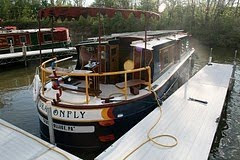 |
| We've cleared the lock in Oswego, headed out of the harbor! |
We stayed in Oswego on Friday, June 15. We spent the
evening getting ready for the most challenging part of this trip: crossing Lake
Ontario.
Eight years ago, when we made the crossing as part of our Great Loop trip, our first day out on the water was rough.
It was cold, and cloudy.
Dragonfly shimmied like a bucking bronco in the
three-foot waves. We had to tack to keep
the rollers from hitting us side on. At
the end of the day I was frozen, seasick, and exhausted.
Will We Make It Across Lake Ontario?
So I was nervous about repeating the crossing. What if we rolled and swamped? Last night we
got out all our safety gear: whistles to tie to our PFDs; waterproof flashlights,
signal flag, portable waterproof marine radio all charged up, cell phones in
double Ziploc bags.
This morning we got up at 6 AM, to stow anything that could
fall off a shelf, or break, or bang around in rough seas. We caught the very first “lock through”
at 7 am, going out through Oswego Canal Lock 8, which separates the canal from
the lake.
 |
| Good-bye Oswego, wish us luck! |
The sun was shining reassuringly. But I was still worried.
How would our new systems perform? Would the motor controller overheat, would
the batteries hold up to the challenge, would the generator shake itself free
of itsmotor mounts?
We put an extra fire extinguisher on deck. Mapped the
marinas along the way in case we needed to bail before our chosen destination,
which was Henderson Harbor, about a 22-mile run.
Cross Lake Ontario? No Problemo
 |
| A perfect day, and all systems go! |
All that worry was needless.
The marine weather forecast had seemed too good to be true: clear skies, warm temperatures, waves less
than one foot. But it WAS true.
We had the most perfect day. The weather was so warm, we were in
shirtsleeves. The waters were perfectly calm. The lighthouses were scenic. We
spotted a pair of loons.
The SlowBoat Solar Technology Report
We alternated between running on battery power only, and
running the generator—which adds charge to the batteries at the same time that
the solar panels are filling them up.
And Cap’s new systems performed so well, we decided to keep
on cruising’ . . . all the way to Cape St. Vincent, about 55 miles of travel
total. Round of applause for the
Dragonfly’s chief engineer, please!
What About Those Hitchhikers?
 |
| This good-looking lighthouse welcomes you to Cape Saint Vincent. |
There was only
one fly in the ointment . . . literally, flies. Hundreds of them. As we passed Grenadier Island, small, odd
looking flies started to settle on our stern solar panels . . . on our deck flowers, on our windows, and on
us.
 |
| Mysterious hitchhikers. Hundreds of 'em. |
They didn’t bite or buzz, they just sat there. We were miles from shore. How did they find us, and why were they
riding along? A mystery.
Happily, as we approached our port, the flies flew off.





Glad you're still using your safety procedures from the boating course!
ReplyDelete